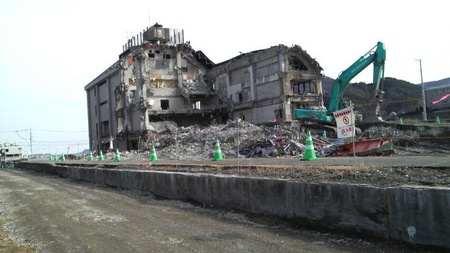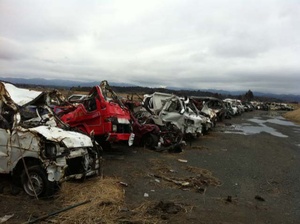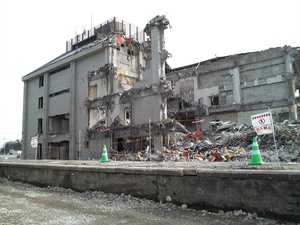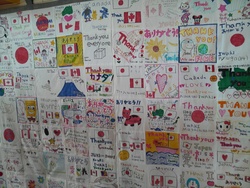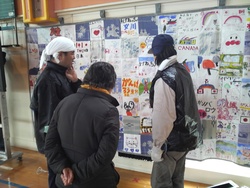I’ll never forget the morning when I heard about the earthquake and tsunami that happened on March 11, 2011. It was a school day.
I had just turned on the TV at around 7 as is my morning habit. It wasn’t long before I saw images of what looked to be an earthquake in Japan and, most shocking of all, in Sendai, the city where I had lived for eight years. The pictures were frantic, hysterical: the numbers on the screen were all a blur, very big, “the largest earthquake in Japanese history”, the loop of pictures of chaos and unbelievable destruction.
I got a phone call from someone at CBC who was looking for a comment.
“Well, when I was living in Japan I remember feeling earthquakes all of the time,” was what I managed not knowing then the extent of the devastation. It would take several heart pounding hours before I would have a clearer picture of what had happened in Sendai and along the coast of Tohoku.
A lot has happened in the subsequent year.
The lives of all of my friends in Sendai are forever changed. Even thought the shock has settled somewhat for most of us here in Tohoku they still have to drive by the remarkable devastation every day. One friend with three kids moved from Fukushima to Tokyo because of concerns about radiation. She is one of the lucky ones.
Let’s turn back the clock of history one year.
On March 11, 2011, Japan was struck by a magnitude 9.0 earthquake which generated a devastating tsunami, with waves estimated to have reached 38 meters high.
The earthquake and subsequent tsunami and nuclear power plant disaster in Fukushima devastated the country and left scars in the hearts of the Japanese people. According to the Red Cross, as of January 30, 2012, 15,845 people were confirmed dead and another 3,375 are still missing.
I’ll let the voices of three friends who are or were in Tohoku tell their stories:
My friend Shogo Horiuchi lives in Minami Soma, Fukushima-ken not far from the Dai Ichi Nuclear Reactor. His family house and rice farm were destroyed by the tsunami.
In an e-mail, he writes: “I feel the plan of reconstruction has not been decided in Fukushima Prefecture especially. The action of Minshuto (government) is too late. Maybe 2 or 3 year later, I think the same as the current situation. Now my work is the sporting away of rubble near Sendai Airport. Here is a lot of rubble.”
My friend Tsutomu Nambu, lives in Sendai, and has been volunteering in the relief effort. In an e-mail, he writes:
Hello Norm-san,
I visited Onagawa on March 5 and 7, and Iwaki on March 9 and 10. It seems that there are a lot of things to do for rebuilding in the affected areas.
The people who have their houses damaged or destroyed are still living in the temporary houses. And the rubble still remains in Tohoku. Only few prefectures are willing to accept it because of the possibility of radioactivity.
It seems to me what is needed for the affected people of Tohoku are:
1. Where they should live?
2. How to make a living?
As for housing, the affected people are allowed to live in the temporary houses for two years. The local governments in Tohoku are thinking of two rebuilding plans for housing. One of them is to build new houses on hills where no tsunami reaches. The other is to build new houses at the original sites raising the ground level. And it seems to the local governments that it is difficult for them to get their residents to consent to their plans.
Moreover, there are financial problems in rebuilding plans. It was last November that the national budget for rebuilding for the great earthquake was drawn up. And all the expenses for the local governments' plans of rebuilding have not been approved by the reconstruction agency, even though the local governments have deficit year after year.
As for making a living, the affected people have to hunt for jobs. Many factories for processing marine products are damaged or destroyed and the workers working there have lost their jobs. It is difficult for them to find new jobs because they are too old to be easily employed.”
Linda Ohama, now back in Vancouver from her base in Onomichi, has been leading a remarkable relief effort since the disaster. She writes:
“We cannot move on so quickly. Spots all over the earth need help but my feeling is beginning to be that if you begin to lend a helping hand, do not take your hand away and leave someone stranded as they are just coming up for air. Running off to the next disaster zone will scatter the real healing that we can be part of. Someone else can go help the next disaster zone. This is how it should work I am beginning to think.
This is why, I have decided that we must stick by Tohoku people and not abandon them.
Abandon them just because it is 12 months since the dramatic tsunami? In more ways than not, this is the most dramatic time they are having to go through.
How to survive? They did that. Now, how to live, they have to build that again. But I know they are tired after all these days, weeks and months. And I know they still need our help and energy. Energy comes in many forms and moves in many different ways.
Tohoku fishing village wives have sent a request to me for life jackets. Their husbands have to try to go out fishing to bring life back to their communities. And their refurbished boats have to go into further waters in order to get safe fish. They have to go away longer. And maybe the wives are stressed because their husbands do not have any safety equipment.
So one fishing village needs 35 life jackets. Now how can this be possible?!
This coming week, I will find them and get them sent. We can do these things and maybe lessen some stress and worry of the wives and maybe even help save one more fisherman.
A few days later, Linda sends an update.
“Guess what??!?!?!
My wooden boatbuilding friend in the States just wrote after I wrote to him about the fishermen in Tohoku.
There is an Alaskan fishing group that has money to donate directly.... can you imagine?!
Just overnight, good things can start falling into place. It makes me still believe.”
© 2012 Norm Ibuki


